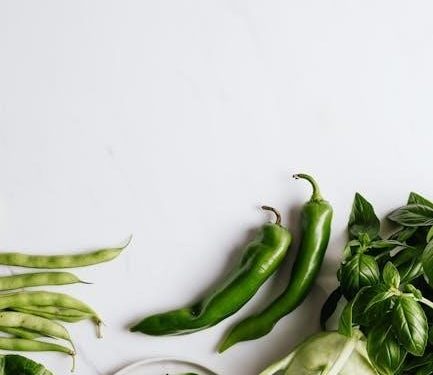
Cruciferous vegetables are a nutrient-rich group of plants known for their versatile use in cuisine and numerous health benefits. They are widely recognized for their potential to enhance well-being.
What Are Cruciferous Vegetables?
Cruciferous vegetables belong to the Brassicaceae family, characterized by their four-petaled flowers and sulfur-containing compounds. They are known for their distinctive flavors and nutritional richness.
2.1. Definition and Origin
Cruciferous vegetables belong to the Brassicaceae family, characterized by their four-petaled flowers. Originating in the Mediterranean and Europe, these plants have been cultivated for centuries. Their name derives from the Latin word crux, meaning “cross,” due to the flower’s unique shape. These vegetables are prized for their nutritional value and versatility in cuisine. They are native to temperate regions and have been a cornerstone in traditional diets worldwide. The term “cruciferous” encompasses a wide variety of edible plants, many of which have been domesticated and selectively bred for desirable traits.
2.2. Key Characteristics
Cruciferous vegetables belong to the Brassicaceae family and are characterized by their distinctive four-petaled flowers. They typically have dark green, leafy structures with a slightly bitter taste. These vegetables are rich in vitamins C and K, fiber, and contain unique compounds like glucosinolates, which contribute to their health benefits. Many have a crunchy texture, while others, like kale, are softer. They thrive in cooler climates and are highly adaptable in culinary preparations, making them a versatile choice for various dishes. Their robust flavors and nutritional density make them a cornerstone in healthy diets worldwide.
2.3. Importance in Diet
Cruciferous vegetables are essential for a balanced diet due to their high nutrient density and low calorie content. They provide vital vitamins like C and K, fiber, and phytochemicals such as glucosinolates, which support overall health. These compounds are linked to chronic disease prevention, including cancer and heart conditions. Incorporating them into meals enhances digestion, boosts immunity, and aids in maintaining healthy weight. Their versatility in various cuisines makes them a valuable addition to diverse dietary plans, promoting long-term well-being and nutritional satisfaction.
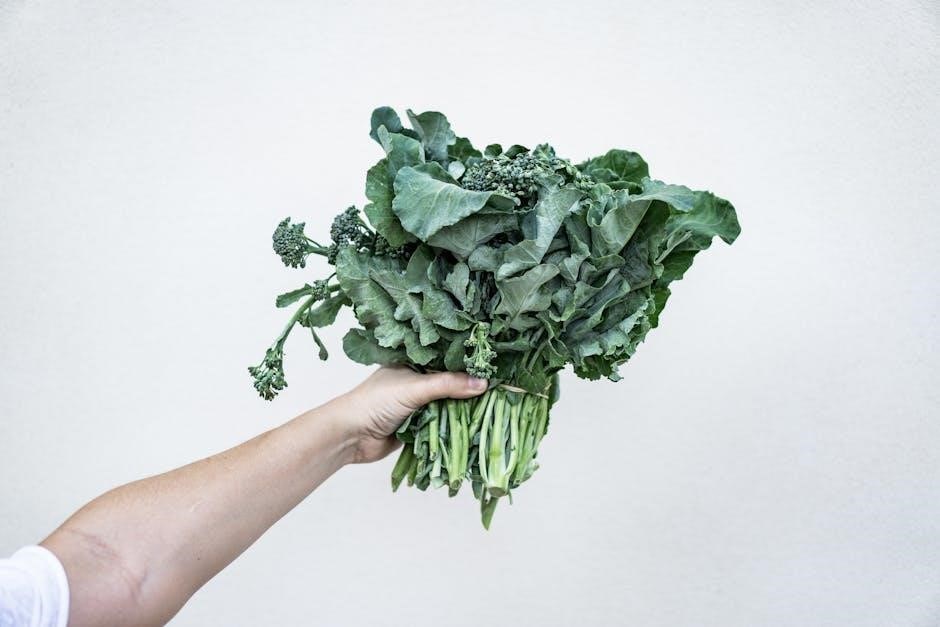
Common Cruciferous Vegetables
Cruciferous vegetables are a diverse and nutritious group, including broccoli, cauliflower, kale, cabbage, Brussels sprouts, and more. They add variety and health benefits to meals.
3.1. Broccoli
Broccoli is one of the most widely consumed cruciferous vegetables, belonging to the Brassica genus. It is native to Italy and is known for its dense, green florets. Broccoli is rich in essential nutrients like Vitamin C, Vitamin K, and fiber. It also contains sulforaphane, a potent compound with antioxidant and anti-inflammatory properties. Broccoli supports immune function, digestion, and has been linked to cancer prevention. It is versatile in cooking, often steamed, roasted, or sautéed. Broccoli is a staple in many cuisines worldwide and is celebrated for its nutritional and culinary value.
3.2. Cauliflower
Cauliflower is a versatile cruciferous vegetable known for its distinctive white, purple, or orange florets. Originating from the Mediterranean, it has gained global popularity. Its mild, slightly sweet flavor and tender yet crunchy texture make it a favorite in various dishes. Cauliflower is a low-calorie, nutrient-dense option, often used as a low-carb substitute in recipes like pizza crusts or rice. It is rich in vitamins C and K, fiber, and antioxidants. Its adaptability in both raw and cooked forms makes it a staple in modern and traditional cuisines, offering numerous health benefits and culinary possibilities.
3.3. Kale
Kale is a highly nutritious, leafy green cruciferous vegetable known for its vibrant colors and robust flavor. It is rich in vitamins A, C, and K, as well as minerals like calcium and iron. Kale contains antioxidants like kaempferol and quercetin, which support overall health. It is also low in calories but high in fiber, making it a popular choice for weight management and digestive health. Kale is versatile in cooking, used in salads, smoothies, soups, and as a roasted snack. Its slightly bitter taste adds depth to various dishes, enhancing both flavor and nutritional value.
Kale has been linked to several health benefits, including reducing inflammation and supporting heart health. It is also known to promote healthy bones and vision due to its high vitamin K and lutein content. With multiple varieties like curly, lacinato, and red Russian, kale offers diverse textures and flavors for culinary exploration. Its popularity has grown significantly in recent years, becoming a staple in health-conscious diets worldwide. Incorporating kale into meals is an excellent way to boost nutrient intake and enjoy a delicious, balanced diet. It is widely available and easy to incorporate into daily meals.
3.4. Cabbage
Cabbage is a versatile and nutritious cruciferous vegetable, available in various colors, including green, red, and purple. It is rich in vitamins C and K, fiber, and antioxidants. Cabbage is known for its dense, leafy heads and mild flavor, making it a staple in many cuisines. It can be consumed raw in salads, fermented as sauerkraut, or cooked in soups and stir-fries. Cabbage supports digestive health and may reduce inflammation due to its high phytochemical content. Its adaptability and nutritional value make it a popular choice for health-conscious diets.
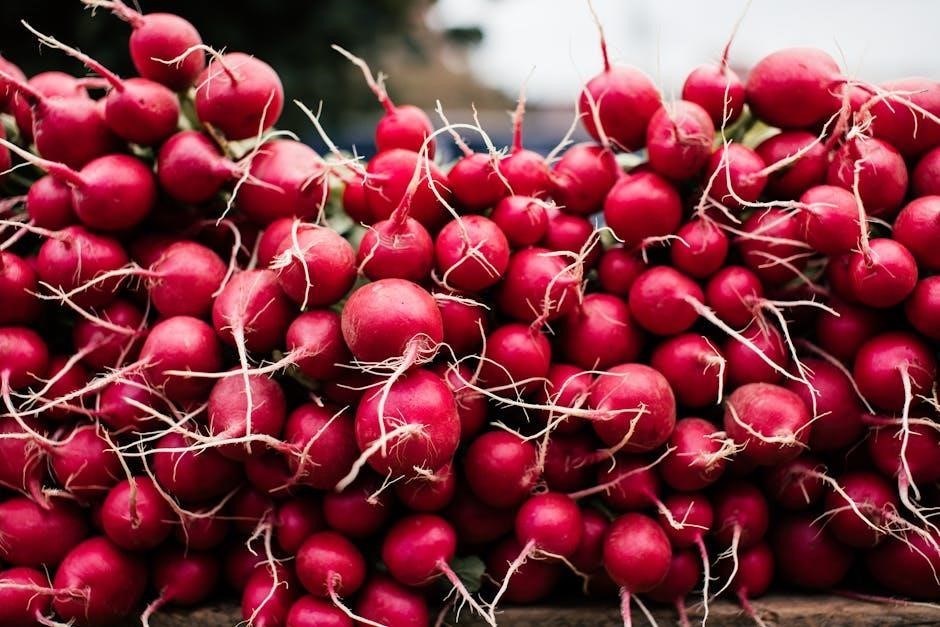
3.5. Bok Choy
Bok choy, also known as Chinese cabbage, is a versatile cruciferous vegetable with green leaves and white, edible stems. It is widely used in Asian cuisine, particularly in stir-fries, soups, and salads. Low in calories but rich in nutrients, bok choy is an excellent source of vitamins A, C, and K, as well as minerals like calcium and iron. Its mild flavor and crisp texture make it a popular choice for both raw and cooked dishes. It is also high in fiber and antioxidants, contributing to its reputation as a healthy addition to various meals.
3.6. Brussels Sprouts
Brussels sprouts are small, green, bud-like vegetables that grow on stalks. They belong to the Brassica family and are native to Brussels, Belgium. Rich in vitamins C and K, fiber, and antioxidants, they are a nutritious addition to diets. Brussels sprouts are versatile in cooking, often roasted, steamed, or sautéed. They have a mild, earthy flavor and a crisp texture when cooked properly. Overcooking can lead to a strong sulfur taste, so brief cooking is recommended. Brussels sprouts are also available in purple and white varieties, offering a colorful and healthy option for various dishes.
3.7. Collard Greens
Collard greens, scientifically known as Brassica oleracea, are a popular cruciferous vegetable native to the Mediterranean region. They are characterized by their large, dark green, fan-like leaves with a slightly bitter and earthy flavor. Often used in Southern American and Brazilian cuisines, collard greens are rich in essential vitamins like A, C, and K, as well as minerals such as calcium and iron. Their chewy texture and versatility make them a great addition to soups, stews, and sautéed dishes. Collard greens also contain fiber and antioxidants, contributing to their reputation as a nutritious and flavorful choice.
3.8. Mustard Greens
Mustard greens are leafy, cruciferous vegetables known for their slightly bitter, peppery flavor and vibrant green color. Native to the Himalayan region, they are widely cultivated and consumed globally. These greens are versatile, often used in soups, sautéed dishes, and salads. They are particularly popular in Southern and Asian cuisines. Mustard greens are rich in essential nutrients like vitamins A, C, and K, as well as minerals such as calcium and iron. Their bold taste makes them a flavorful addition to various recipes, and they can be cooked in numerous ways to suit different culinary preferences.
3.9. Turnips
Turnips (Brassica rapa) are root vegetables belonging to the Brassicaceae family. They are characterized by their bulbous, sweet, and slightly peppery flavor. Turnips are typically white or purple, with a crunchy texture when raw and a tender consistency when cooked. They are versatile in culinary uses, often roasted, boiled, or pickled. Turnips are a good source of vitamins C and K, fiber, and antioxidants, making them a nutritious addition to a balanced diet. They also contain compounds that may support immune function and aid in digestion. Turnips are widely cultivated and enjoyed across various cuisines globally.
3.10. Rutabaga
Rutabaga, also known as swede, is a cross between a cabbage and a turnip, offering a sweet, earthy flavor. Its thick, waxy skin ranges in color from yellow to purple, while the flesh is pale yellow. Rutabagas are versatile, used in both savory and sweet dishes, such as mashes, roasts, soups, and stews. They are a good source of vitamins C and K, fiber, and antioxidants. Rutabagas are also low in calories, making them a nutritious addition to balanced diets. They are widely available and can be stored for months when kept cool and dry.
3.11. Arugula
Arugula, also known as rocket, is a peppery-tasting cruciferous vegetable with dark green, lobed leaves. Native to the Mediterranean, it is prized for its bold flavor and versatility in salads, sauces, and as a garnish. Rich in vitamins A, C, and K, arugula also contains antioxidants like glucosinolates, which may support health. Its slightly bitter taste pairs well with citrus, cheeses, and nuts, making it a popular choice in modern cuisine. Arugula is also a good source of fiber and is low in calories, contributing to its reputation as a nutritious and flavorful addition to various dishes.
3.12. Watercress
Watercress is a fast-growing, aquatic leafy green known for its peppery flavor and crisp texture. Native to Europe and Asia, it thrives in cool, flowing water. Rich in vitamins A, C, and K, watercress is also a good source of minerals like calcium and iron. Its low calorie count and high antioxidant content make it a popular choice for salads, sandwiches, and soups. Watercress is versatile in both raw and cooked dishes, adding a refreshing zing to various recipes. It is widely available in most supermarkets and is celebrated for its nutritional and culinary value.
Health Benefits of Cruciferous Vegetables
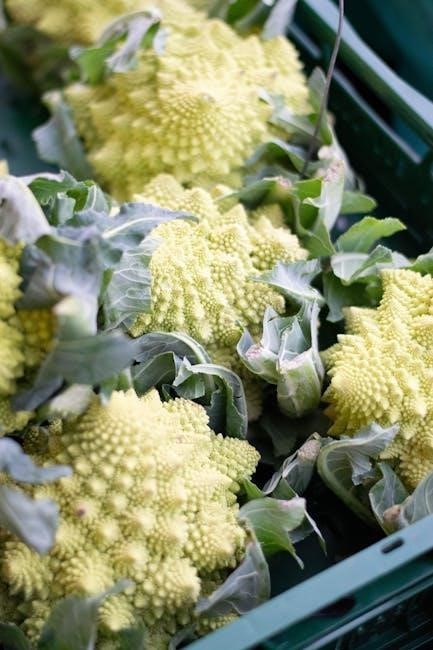
Cruciferous vegetables are renowned for their exceptional health benefits, including cancer prevention, antioxidant richness, and anti-inflammatory properties. They support digestion, immunity, and overall well-being effectively.
4.1. Cancer Prevention
Cruciferous vegetables contain compounds like glucosinolates, isothiocyanates, and sulforaphane, which have been linked to cancer prevention. These phytochemicals help inhibit cancer cell growth and induce apoptosis. Studies suggest they may reduce the risk of colon, breast, prostate, and lung cancers by detoxifying carcinogens and reducing inflammation. The antioxidants in these vegetables also protect cells from oxidative damage, further lowering cancer risk. While more research is needed, the evidence highlights their potential role in a cancer-preventive diet.
4.2. Antioxidant Content
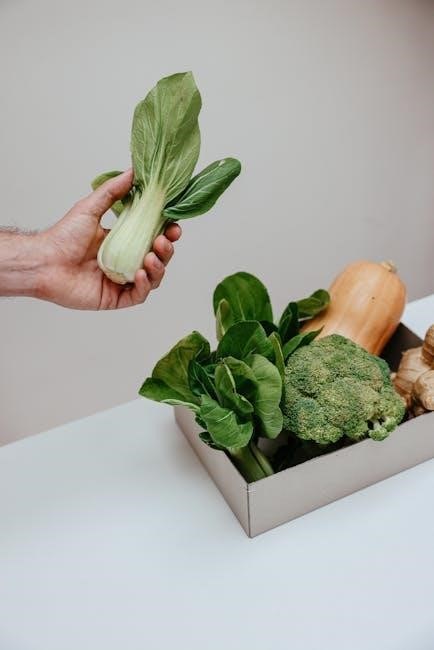
Cruciferous vegetables are packed with antioxidants like vitamins C and E, beta-carotene, and polyphenols, which help combat free radicals and reduce oxidative stress. These compounds play a crucial role in protecting cells from damage, potentially lowering the risk of chronic diseases. Specific antioxidants, such as glucosinolates, are unique to this vegetable family and have been linked to detoxifying properties. The colorful varieties, like broccoli, kale, and Brussels sprouts, are particularly rich in these protective molecules. Incorporating these vegetables into your diet can significantly boost your antioxidant intake, promoting overall health and well-being.
- Rich in vitamins C and E, beta-carotene, and polyphenols.
- Glucosinolates provide detoxifying properties.
- Colorful varieties offer higher antioxidant concentrations.
4.3. Anti-Inflammatory Properties
Cruciferous vegetables are renowned for their potent anti-inflammatory properties, which play a crucial role in reducing chronic inflammation. These vegetables contain a wealth of antioxidants, including vitamins C and E, and polyphenols, which combat harmful free radicals in the body. Specific compounds like sulforaphane, found in broccoli, and isothiocyanates have been shown to inhibit pro-inflammatory enzymes, thereby lessening inflammation. Additionally, their high fiber content supports gut health, further contributing to an anti-inflammatory environment. Regular consumption of these vegetables may help mitigate the risk of chronic diseases such as arthritis and cardiovascular conditions. Their culinary versatility ensures they can easily be incorporated into a balanced diet.
4.4. Digestive Health
Cruciferous vegetables play a significant role in promoting digestive health due to their high fiber content, which helps prevent constipation and supports regular bowel movements. The fiber also acts as a prebiotic, feeding beneficial gut bacteria and fostering a balanced microbiome. Additionally, these vegetables contain sulforaphane, a compound that may protect the gut lining from damage and reduce inflammation in the digestive tract. A diet rich in cruciferous vegetables can help alleviate symptoms of irritable bowel syndrome and support overall gut well-being, making them a valuable addition to a healthy digestive regimen.
4.5. Immune System Support
Cruciferous vegetables are rich in vitamins C and E, which play a crucial role in boosting the immune system. These vitamins help protect cells from damage and support the production of white blood cells. Additionally, the high content of beta-carotene in these vegetables converts to vitamin A in the body, further enhancing immune function. The sulfur compounds found in cruciferous vegetables may also stimulate the production of antibodies, helping the body fight off pathogens more effectively. Regular consumption can contribute to a stronger, more resilient immune system, reducing the risk of infections and illnesses.
4.6. Bone Health
Cruciferous vegetables are rich in calcium, vitamin K, and magnesium, all essential for maintaining strong bones. They support bone mineral density, reducing the risk of osteoporosis and fractures. The high vitamin K content helps regulate calcium metabolism, while magnesium enhances bone mineralization. Additionally, these vegetables contain phytochemicals that may protect against bone loss, making them a valuable dietary component for overall skeletal health. Incorporating them into meals can contribute to long-term bone strength and reduce the likelihood of age-related bone disorders.
4.7. Cardiovascular Health
Cruciferous vegetables play a significant role in promoting cardiovascular health by reducing inflammation and improving blood flow. They are rich in antioxidants like vitamin C and potassium, which help lower blood pressure and cholesterol levels. The fiber content aids in maintaining healthy cholesterol levels, while glucosinolates support the detoxification processes that protect blood vessels. Regular consumption of these vegetables has been linked to a reduced risk of heart disease, atherosclerosis, and stroke. Their ability to improve lipid profiles and enhance endothelial function makes them a valuable addition to a heart-healthy diet.
Nutritional Profile
Cruciferous vegetables are rich in vitamins C and K, fiber, and minerals like calcium and iron. They also contain antioxidants and phytochemicals, offering a nutrient-dense, low-calorie diet option.
5.1. Vitamins and Minerals
Cruciferous vegetables are rich in essential vitamins and minerals, including vitamin C, vitamin K, and folate. They also contain significant amounts of calcium, iron, and potassium. These nutrients support immune function, bone health, and energy production. Additionally, they provide B vitamins, which are crucial for metabolism and nerve function. The mineral content varies among types, but most offer a balanced mix of manganese, magnesium, and zinc. This diverse nutritional profile makes them a valuable addition to a healthy diet, supporting overall well-being and reducing the risk of deficiencies.
5.2. Fiber Content
Cruciferous vegetables are excellent sources of dietary fiber, essential for healthy digestion and bowel function. Fiber helps regulate blood sugar levels, promotes satiety, and supports gut health. Vegetables like broccoli, Brussels sprouts, and kale contain both soluble and insoluble fiber, aiding in proper nutrient absorption and waste elimination. A high-fiber diet can also contribute to weight management and reduce the risk of chronic diseases, such as heart disease and type 2 diabetes. Incorporating these vegetables into meals ensures a significant intake of this vital nutrient, enhancing overall well-being.
5.3. Phytochemicals
Cruciferous vegetables are rich in phytochemicals, including glucosinolates, which convert into isothiocyanates like sulforaphane during digestion. These compounds are renowned for their anti-cancer properties and ability to support detoxification processes. Phytochemicals also act as antioxidants, protecting cells from oxidative damage and inflammation. Additionally, they play a role in regulating immune function and hormone metabolism. The unique combination of phytochemicals in cruciferous vegetables contributes to their potential to reduce chronic disease risk. Cooking methods can influence phytochemical retention, with light steaming often preserving these compounds better than boiling. Their bioactive properties make them a valuable addition to a healthy diet.
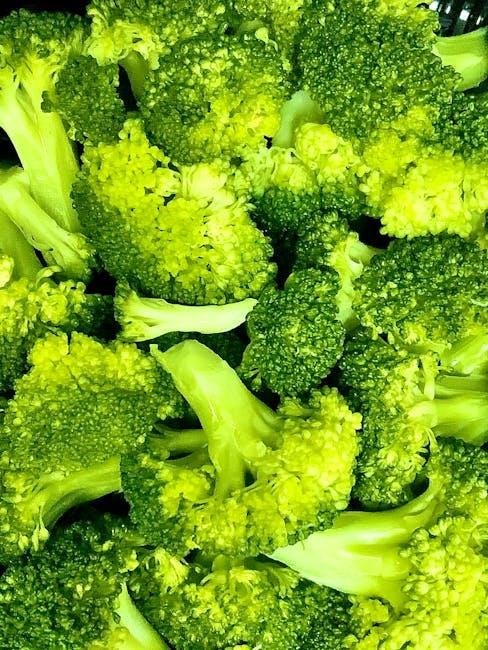
Culinary Uses
Cruciferous vegetables offer versatility in various culinary applications. They can be enjoyed raw in salads, roasted for a hearty side, or sautéed as a nutritious addition to meals.
- Stir-fried with garlic
- Roasted for a crispy texture
- Added to soups
- Sautéed as a side
- Steamed for tenderness
- Pickled for a tangy snack
6.1. Cooking Methods
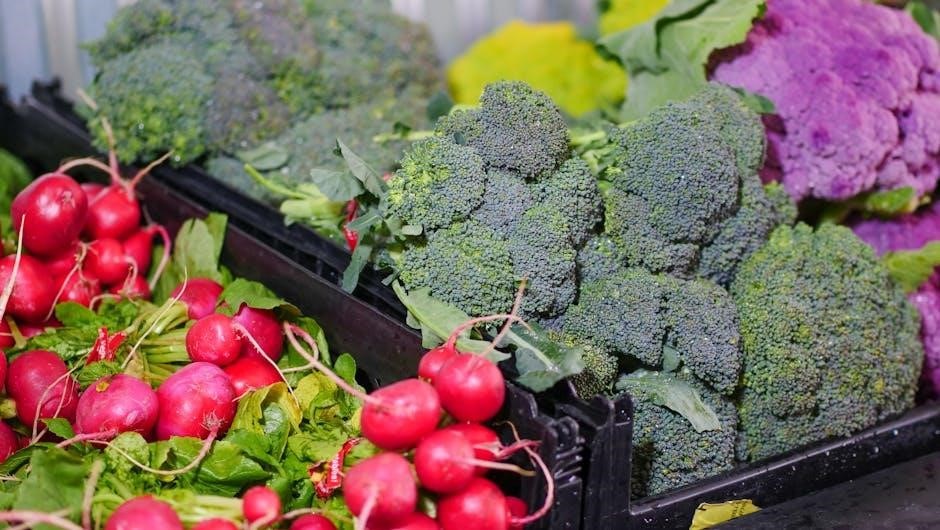
Cruciferous vegetables can be prepared using various methods to enhance flavor and texture while retaining nutrients. Steaming is ideal for preserving vitamins and minerals, while roasting brings out natural sweetness. Sautéing or stir-frying with olive oil and garlic adds depth without overcooking. Boiling is simple but may lose nutrients in water. Grilling or baking can caramelize flavors, creating a crispy texture. Fermenting, as in sauerkraut or kimchi, enhances digestibility and adds probiotics. Each method offers unique benefits, allowing versatility in incorporating these vegetables into diverse recipes and dietary preferences.
6.2. Incorporating into Diets
Incorporating cruciferous vegetables into daily meals can be simple and delicious. Add broccoli, kale, or spinach to salads, smoothies, or stir-fries for a nutrient boost. Roasted Brussels sprouts or cauliflower make flavorful side dishes, while sautéed cabbage or bok choy can enhance soups and sauces. For a balanced diet, aim to include a variety of these vegetables across different meals. They can also be used as healthy alternatives in recipes, such as cauliflower rice or kale chips. Experimenting with preparation methods ensures diversity and keeps meals exciting while reaping their nutritional benefits.
6.3. Recipe Ideas
Cruciferous vegetables offer endless culinary possibilities. Try roasting broccoli with garlic and olive oil for a crispy side dish, or blend cauliflower into a creamy, low-carb mashed “potato.” Sauté kale with lemon and chili flakes for a zesty salad topping. Steam Brussels sprouts and toss with balsamic glaze for a sweet-and-sour flavor. Add shredded cabbage to stir-fries or ferment it into sauerkraut. For a hearty soup, combine collard greens, beans, and spices. These versatile veggies can elevate any meal, whether you’re aiming for comfort food or a fresh, healthy twist.
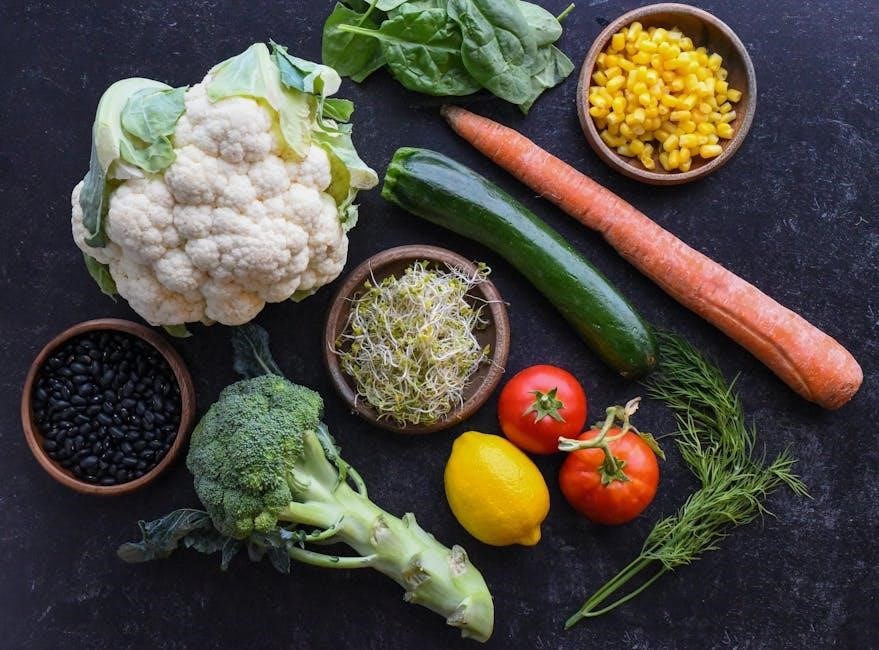
Potential Allergies and Intolerances
Some individuals may experience allergies or intolerances to cruciferous vegetables, often due to specific compounds like sulfur or raffinose. Symptoms can include digestive discomfort, bloating, or skin reactions.
- Allergies are rare but can cause severe reactions.
- Intolerances may lead to mild gastrointestinal issues.
- Sensitivities vary widely among individuals.
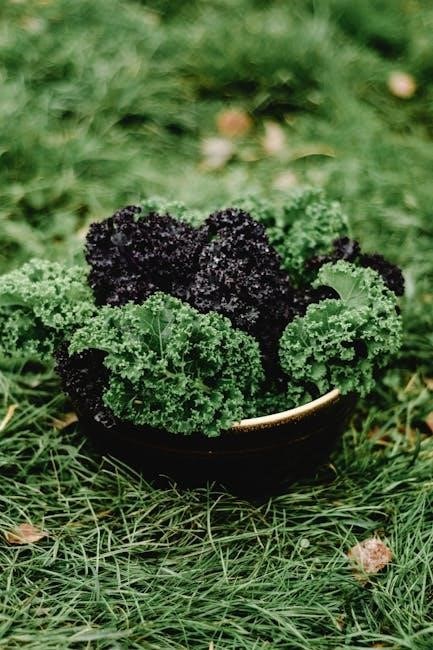
7.1. Common Allergies
While generally safe, cruciferous vegetables can cause allergic reactions in some individuals. Symptoms may include hives, swelling, or digestive discomfort. The immune system mistakenly identifies certain proteins in these vegetables as harmful, triggering an allergic response. Such reactions are rare but can be severe in sensitive individuals. Common allergenic cruciferous vegetables include broccoli, kale, and cauliflower. Allergies can develop at any age, and severity varies widely. If suspecting an allergy, consulting a healthcare professional for proper diagnosis and management is crucial. Proper identification ensures appropriate dietary adjustments to avoid adverse reactions.
7.2. Intolerances and Sensitivities
Some individuals may experience intolerances or sensitivities to cruciferous vegetables due to their sulfur content, which can cause mild digestive discomfort. Raffinose, a complex sugar, is often poorly absorbed, leading to gas and bloating. Additionally, compounds like goitrogens in raw cruciferous vegetables may interfere with thyroid function in susceptible individuals. For those with irritable bowel syndrome (IBS), the high FODMAP content in some varieties can trigger symptoms. However, tolerances vary widely, and cooking or fermentation can reduce these compounds, making them more digestible for sensitive individuals.
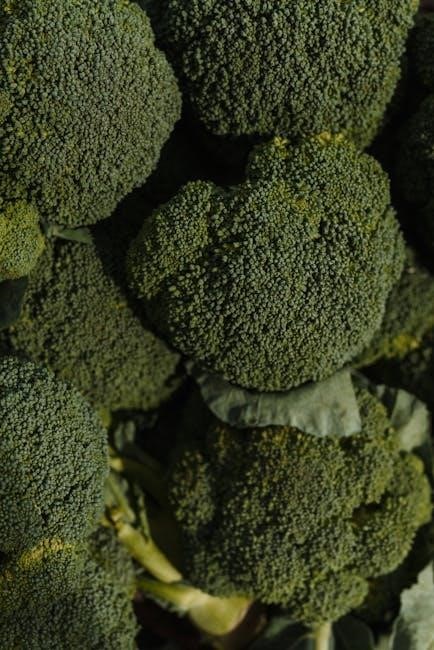
Environmental Impact
Cruciferous vegetables contribute positively to environmental sustainability through efficient water and nutrient use, supporting eco-friendly farming practices and reducing carbon footprints in cultivation and distribution processes.
8.1. Sustainability
Cruciferous vegetables are generally sustainable due to their relatively low water requirements and ability to grow in diverse climates. Many varieties are cultivated using organic farming methods, reducing chemical use. They often serve as rotation crops, improving soil health and preventing pests. Local and seasonal production minimizes transportation emissions, making them eco-friendly choices. Additionally, their hardiness reduces the need for pesticides, further benefiting the environment. Overall, cruciferous vegetables contribute positively to sustainable agriculture and food systems.
- Low water needs
- Support soil health
- Encourage organic practices
- Reduce environmental impact
8.2. Seasonal Availability
Cruciferous vegetables are typically cool-season crops, thriving in temperate climates during spring and fall. Many varieties, like broccoli and Brussels sprouts, are harvested from September to April. However, modern farming techniques and greenhouse production extend their availability in some regions. In warmer climates, they may grow during winter months. Seasonal availability varies by location, but most cruciferous vegetables can be found fresh in local markets during their natural growing periods. Global distribution often ensures year-round access, though peak flavor and texture are typically experienced in season.
Understanding seasonal patterns helps in enjoying these vegetables at their best, supporting local farmers, and reducing environmental impact.
Cultural Significance
Cruciferous vegetables hold significant cultural value, featuring prominently in traditional cuisines worldwide. They are celebrated for their versatility and historical use in dishes across various societies and cuisines.
9.1. Historical Use
Cruciferous vegetables have a long history dating back thousands of years, with evidence of their cultivation in ancient Rome, China, and Europe. These vegetables were valued for their durability, nutritional richness, and versatility in cooking. In traditional medicine, they were used to treat various ailments due to their perceived health benefits. Ancient civilizations also recognized their adaptability to different climates, making them a staple in many regional diets. Their historical significance is evident in their inclusion in traditional recipes and their role in cultural practices, highlighting their enduring importance across generations.
9.2. Role in Traditional Cuisines
Cruciferous vegetables have long been integral to traditional cuisines worldwide, particularly in Asian, European, and Mediterranean diets. In Chinese cuisine, bok choy and napa cabbage are staples in stir-fries and soups, while Japanese cuisine features komatsuna and cabbage in dishes like miso soup and sunomono salads. In Korea, napa cabbage is fermented to make kimchi, a national dish. Similarly, in Eastern Europe, sauerkraut (fermented cabbage) and pierogi filled with sauerkraut or kale are traditional. These vegetables also appear in Mediterranean dishes, such as Greek salads and Italian pasta recipes. Their versatility and flavor make them indispensable in global culinary traditions.